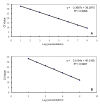Ambient stable quantitative PCR reagents for the detection of Yersinia pestis
- PMID: 20231881
- PMCID: PMC2834737
- DOI: 10.1371/journal.pntd.0000629
Ambient stable quantitative PCR reagents for the detection of Yersinia pestis
Abstract
Background: Although assays for detecting Yersinia pestis using TaqMan probe-based real-time PCR have been developed for years, little is reported on room-temperature-stable PCR reagents, which will be invaluable for field epidemic surveillance, immediate response to public health emergencies, counter-bioterrorism investigation, etc. In this work, a set of real-time PCR reagents for rapid detection of Y. pestis was developed with extraordinary stability at 37 degrees C.
Methods/principal findings: TaqMan-based real-time PCR assays were developed using the primers and probes targeting the 3a sequence in the chromosome and the F1 antigen gene caf1 in the plasmid pMT1of Y. pestis, respectively. Then, carbohydrate mixtures were added to the PCR reagents, which were later vacuum-dried for stability evaluation. The vacuum-dried reagents were stable at 37 degrees C for at least 49 days for a lower concentration of template DNA (10 copies/microl), and up to 79 days for higher concentrations (> or =10(2) copies/microl). The reagents were used subsequently to detect soil samples spiked with Y. pestis vaccine strain EV76, and 5x10(4) CFU per gram of soil could be detected by both 3a- and caf1-based PCR reagents. In addition, a simple and efficient method for soil sample processing is presented here.
Conclusions/significance: The vacuum-dried reagents for real-time PCR maintain accuracy and reproducibility for at least 49 days at 37 degrees C, indicating that they can be easily transported at room temperature for field application if the machine for performing real-time PCR is available. This dry reagent is of great significance for routine plague surveillance.
Conflict of interest statement
The authors have declared that no competing interests exist.
Figures

Similar articles
-
Development and evaluation of a multi-target droplet digital PCR assay for highly sensitive and specific detection of Yersinia pestis.PLoS Negl Trop Dis. 2024 May 3;18(5):e0012167. doi: 10.1371/journal.pntd.0012167. eCollection 2024 May. PLoS Negl Trop Dis. 2024. PMID: 38701065 Free PMC article.
-
Development and evaluation of loop-mediated isothermal amplification for detection of Yersinia pestis in plague biological samples.PLoS One. 2020 Aug 18;15(8):e0237655. doi: 10.1371/journal.pone.0237655. eCollection 2020. PLoS One. 2020. PMID: 32810167 Free PMC article.
-
Real-time multiplex PCR assay for detection of Yersinia pestis and Yersinia pseudotuberculosis.APMIS. 2009 Jan;117(1):34-44. doi: 10.1111/j.1600-0463.2008.00013.x. APMIS. 2009. PMID: 19161535
-
[Methods of diagnosis and differentiation of plague pathogen: approaches to detection of atypical strains of Yersinia pestis by molecular biology. Part I].Mol Gen Mikrobiol Virusol. 2006;(1):3-6. Mol Gen Mikrobiol Virusol. 2006. PMID: 16512602 Review. Russian.
-
Molecular genetic methods for the diagnosis of fastidious microorganisms.APMIS. 2004 Nov-Dec;112(11-12):785-807. doi: 10.1111/j.1600-0463.2004.apm11211-1206.x. APMIS. 2004. PMID: 15638838 Review.
Cited by
-
The Natural and Clinical History of Plague: From the Ancient Pandemics to Modern Insights.Microorganisms. 2024 Jan 11;12(1):146. doi: 10.3390/microorganisms12010146. Microorganisms. 2024. PMID: 38257973 Free PMC article. Review.
-
Calibration of an Upconverting Phosphor-Based Quantitative Immunochromatographic Assay for Detecting Yersinia pestis, Brucella spp., and Bacillus anthracis Spores.Front Cell Infect Microbiol. 2020 Apr 24;10:147. doi: 10.3389/fcimb.2020.00147. eCollection 2020. Front Cell Infect Microbiol. 2020. PMID: 32391285 Free PMC article.
-
Yersinia pestis: the Natural History of Plague.Clin Microbiol Rev. 2020 Dec 9;34(1):e00044-19. doi: 10.1128/CMR.00044-19. Print 2020 Dec 16. Clin Microbiol Rev. 2020. PMID: 33298527 Free PMC article. Review.
-
Development and evaluation of a multi-target droplet digital PCR assay for highly sensitive and specific detection of Yersinia pestis.PLoS Negl Trop Dis. 2024 May 3;18(5):e0012167. doi: 10.1371/journal.pntd.0012167. eCollection 2024 May. PLoS Negl Trop Dis. 2024. PMID: 38701065 Free PMC article.
-
Yersinia pestis detection by loop-mediated isothermal amplification combined with magnetic bead capture of DNA.Braz J Microbiol. 2018 Jan-Mar;49(1):128-137. doi: 10.1016/j.bjm.2017.03.014. Epub 2017 Aug 26. Braz J Microbiol. 2018. PMID: 28887007 Free PMC article.
References
-
- Inglesby TV, Dennis DT, Henderson DA, Bartlett JG, Ascher MS, et al. Plague as a biological weapon: medical and public health management. Working Group on Civilian Biodefense. Jama. 2000;283:2281–2290. - PubMed
-
- Greenfield RA, Bronze MS. Prevention and treatment of bacterial diseases caused by bacterial bioterrorism threat agents. Drug Discov Today. 2003;8:881–888. - PubMed
-
- Gaval SR, Shrikhande SN, Makhija SK, Tankhiwale NS, Pathak AA, et al. Study of suspected plague cases for isolation and identification of Yersinia pestis. Indian J Med Sci. 1996;50:335–338. - PubMed
-
- Nunes MP, Suassuna I. Bacteriophage specificity in the identification of Yersinia pestis as compared with other enterobacteria. Rev Bras Pesqui Med Biol. 1978;11:359–363. - PubMed
Publication types
MeSH terms
Substances
LinkOut - more resources
Full Text Sources
Other Literature Sources
Molecular Biology Databases

